Click on images to enlarge
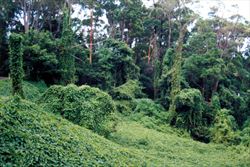
large infestation (Photo: Land Protection, QDNRW)
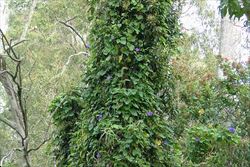
climbing habit (Photo: Sheldon Navie)
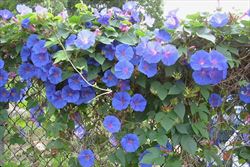
habit growing on a fence (Photo: Sheldon Navie)
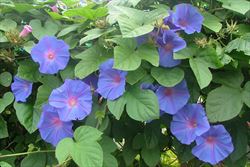
leaves and bluish flowers (Photo: Sheldon Navie)
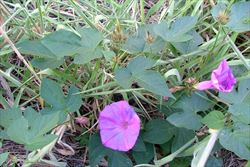
leaves and purplish flowers (Photo: Sheldon Navie)

close-up of stem, with adventitious roots beginning to form, and leaf stalk (Photo: Sheldon Navie)
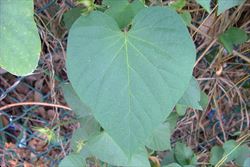
heart-shaped leaf (Photo: Sheldon Navie)
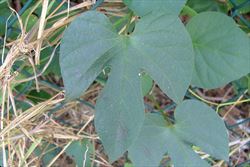
three-lobed leaf (Photo: Sheldon Navie)

close-up of leaf underside (Photo: Sheldon Navie)
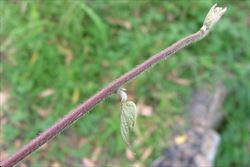
close-up of hairy young shoot (Photo: Sheldon Navie)
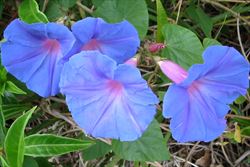
tubular flowers (Photo: Sheldon Navie)
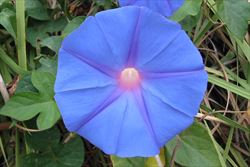
close-up of flower with paler centre (Photo: Sheldon Navie)
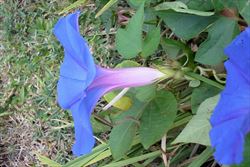
flower from side-on, showing paler floral tube with long and narrow sepals (Photo: Sheldon Navie)
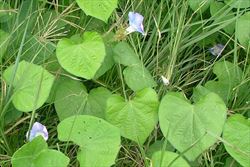
the similar ivy-leaf morning glory (Ipomoea hederacea) has smaller flowers and strongly curved sepals (Photo: Sheldon Navie)
Scientific Name
Ipomoea indica (Burm.) Merr.
Synonyms
Convolvulus acuminatus VahlConvolvulus congestus (R. Br.) Spreng.Convolvulus indicus Burm.Ipomoea acuminata (Vahl) Roem. & Schult.Ipomoea cataractae Endl.Ipomoea congesta R. Br.Ipomoea insularis (Choisy) Steud.Ipomoea leari PaxtonIpomoea learii PaxtonPharbitis insularis Choisy
Family
Convolvulaceae
Common Names
blue dawn flower, blue dawn-flower, blue dawnflower, blue morning glory, blue morning-glory, blue morningglory, common morning glory, convolvulus, dunny creeper, Lear's morning glory, morning glory, ocean blue morningglory, oceanblue morning glory, oceanblue morning-glory, oceanblue morningglory, purple morning glory, purple morningglory
Origin
Probably native to the tropics of Central and South America, and possibly also native to south-eastern Asia (i.e. pan-tropical).
Cultivation
Blue morning glory (Ipomoea indica) has been widely cultivated as a garden ornamental, and can still often be seen growing in gardens in coastal districts.
Naturalised Distribution
Widely naturalised in, particularly in the coastal districts of eastern Australia. Common in eastern Queensland and the coastal districts of eastern New South Wales. Also naturalised in south-western and western Western Australia, in south-eastern South Australia, in southern Victoria, on Lord Howe Island and on Norfolk Island.
Naturalised overseas in southern Europe, southern Africa, New Zealand, southern USA and on several Pacific islands.
Habitat
This species inhabits wetter tropical, sub-tropical and temperate regions. It is particularly common in suburban gullies, gardens, along roadsides and waterways and in disturbed rainforest. Also a weed of summer crops, plantations, open woodlands, disturbed sites and waste areas.
Habit
A long-lived (i.e. perennial) twining climber growing up to 15 m high, but sometimes scrambling over low vegetation or creeping along the ground.
Distinguishing Features
- a showy twining climber or scrambling plant with hairy stems.
- its alternately arranged leaves (5-18 cm long and 3.5-16 cm wide) are either heart-shaped or three-lobed.
- its large funnel-shaped flowers (5-10 cm long and 7-10 cm across) are blue or bluish-purple in colour with pale pinkish centres.
- these flowers have long and narrow sepals (14-22 mm long) and are borne in clusters of two to twelve in the leaf forks.
- this species does not produce viable seed in Australia, and fruiting capsules are rarely seen here.
Stems and Leaves
The stems usually develop a twining habit although they occasionally spread across the ground (i.e. they are sometimes prostrate). These stems are fairly densely covered in spreading or backwards-curved (i.e. retrorse) hairs when young and they occasionally also exude a white milky sap when broken.
The alternately arranged leaves (5-18 cm long and 3.5-16 cm wide) are borne on stalks (i.e. petioles) 2-18 cm long. They range from heart-shaped (i.e. cordate) to obviously three-lobed and have pointed tips (i.e. acute apices). Both leaf surfaces are softly hairy, the undersides more so.
Flowers and Fruit
The funnel-shaped (i.e. tubular) flowers are bright blue or bluish-purple in colour with a paler pink or whitish-pink central tube. These large flowers (5-10 cm long and 7-10 cm across) are borne in clusters of two to twelve in the leaf forks (i.e. axils). They have five long and narrow sepals (14-22 mm long). Flowering occurs throughout the year but is most abundant during spring, summer and autumn.
The fruit are globular papery capsules (about 10 mm across) containing four to six dark brown or black coloured seeds. However, capsules are rarely produced and viable seed is not set in Australia.
Reproduction and Dispersal
This plant reproduces vegetatively via rooting stems and can sometimes also produce seed (overseas only).
Stem fragments are commonly spread by water, animals and in dumped garden waste. They may also be dispersed by slashers, movers and other vehicles.
Environmental Impact
Blue morning glory (Ipomoea indica) is a significant environmental weed in Queensland, New South Wales and Victoria, and an environmental weed in South Australia and Western Australia. It was also recently listed as a priority environmental weed in at least one Natural Resource Management region.
Legislation
This species is declared under legislation in the following states and territories:
- New South Wales: Class 4 - a locally controlled weed. The growth and spread of this species must be controlled according to the measures specified in a management plan published by the local control authority and the plant may not be sold, propagated or knowingly distributed (in the Campbelltown, Hornsby, Hunters Hill, Ku-ring-gai, Lane Cove, Manly, Mosman, North Sydney, Parramatta, Pittwater, Ryde, Warringah and Willoughby local authority areas only).
- Western Australia: Unassessed - this species is declared in other states or territories and is prohibited until assessed via a weed risk assessment (throughout the entire state).
Management
For information on the management of this species see the following resources:
- the Biosecurity Queensland Fact Sheet on this species, which is available online at http://www.dpi.qld.gov.au.
- the Strathfield Council weed fact sheet on morning glory species, which is available online at http://www.strathfield.nsw.gov.au.
- the Sutherland Shire Council weed fact on morning glory species, which is available online at http://www.sutherland.nsw.gov.au.
- the Randwick City Council environmental weeds profile on this species, which is available online at http://www.randwick.nsw.gov.au.
Similar Species
Blue morning glory (Ipomoea indica) is very similar to coastal morning glory (Ipomoea cairica), common morning glory (Ipomoea purpurea) and ivy-leaved morning glory (Ipomoea hederacea). These species can be distinguished by the following differences:
- blue morning glory (Ipomoea indica) has hairy (i.e. pubescent) younger stems and heart-shaped (i.e. cordate) or three-lobed leaves. Its flowers are relatively large (7-10 cm across), its sepals are long and thin (14-22 mm long), and it does not produce viable seeds (capsules are generally not seen).
- coastal morning glory (Ipomoea cairica) has hairless (i.e. glabrous) stems and five to seven lobed leaves that resemble the fingers of a hand (i.e. they are palmately lobed). Its flowers are relatively large (5-8 cm across), its sepals are relatively short (4-7 mm long), and it often produces capsules containing four hairy seeds.
- common morning glory (Ipomoea purpurea) has hairy (i.e. pubescent) younger stems and heart-shaped (i.e. cordate) or three-lobed leaves. Its flowers are relatively large (3-7 cm across), its sepals are moderately long (10-15 mm long), and it often produces capsules containing six hairless seeds.
- ivy-leaved morning glory (Ipomoea hederacea) has hairy (i.e. pubescent) younger stems and heart-shaped (i.e. cordate) or three-lobed leaves. Its flowers are relatively small (3-5 cm across), its strongly curved sepals are long and thin (about 20 mm long), and it often produces capsules containing four to six hairless seeds.

